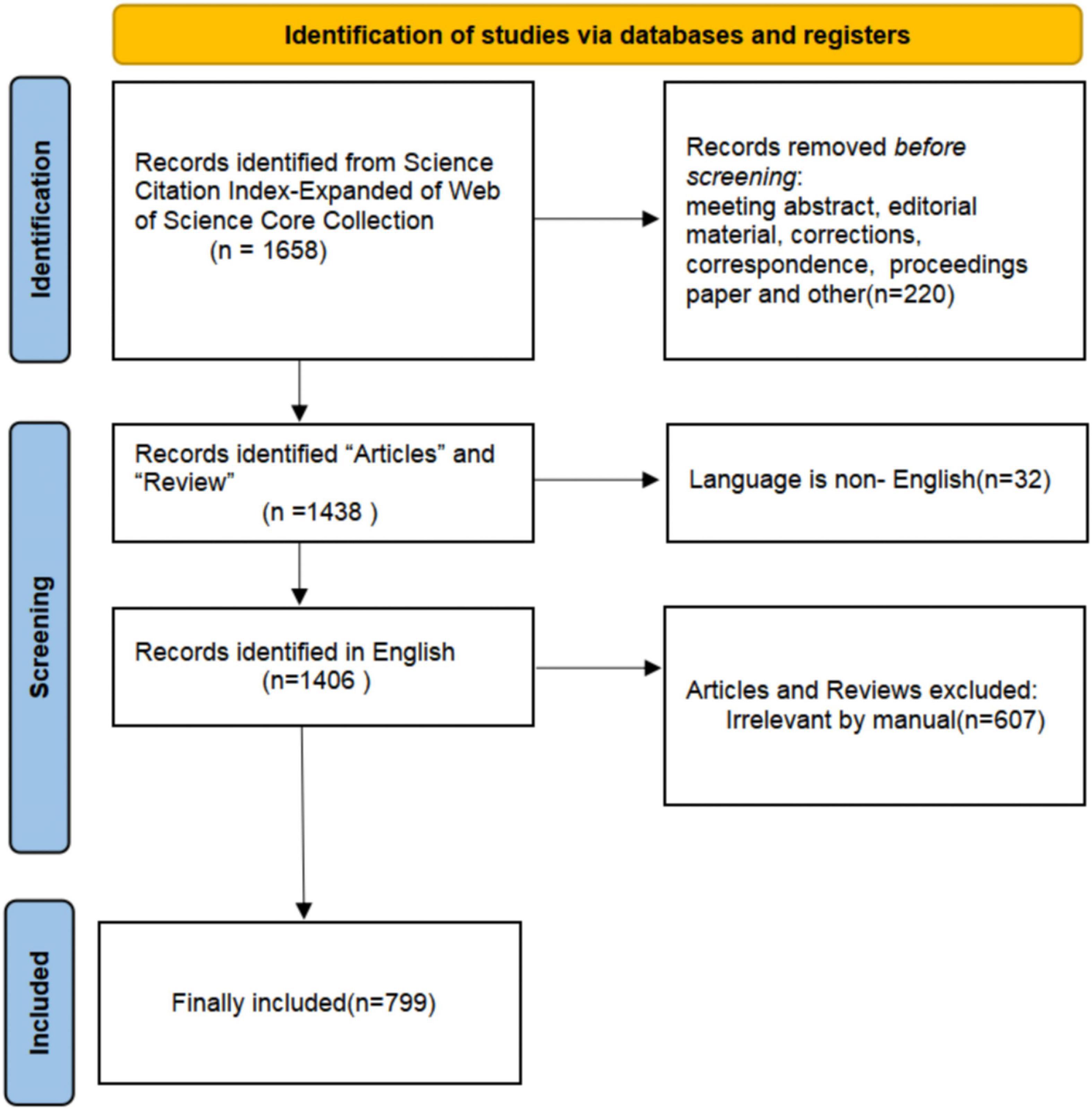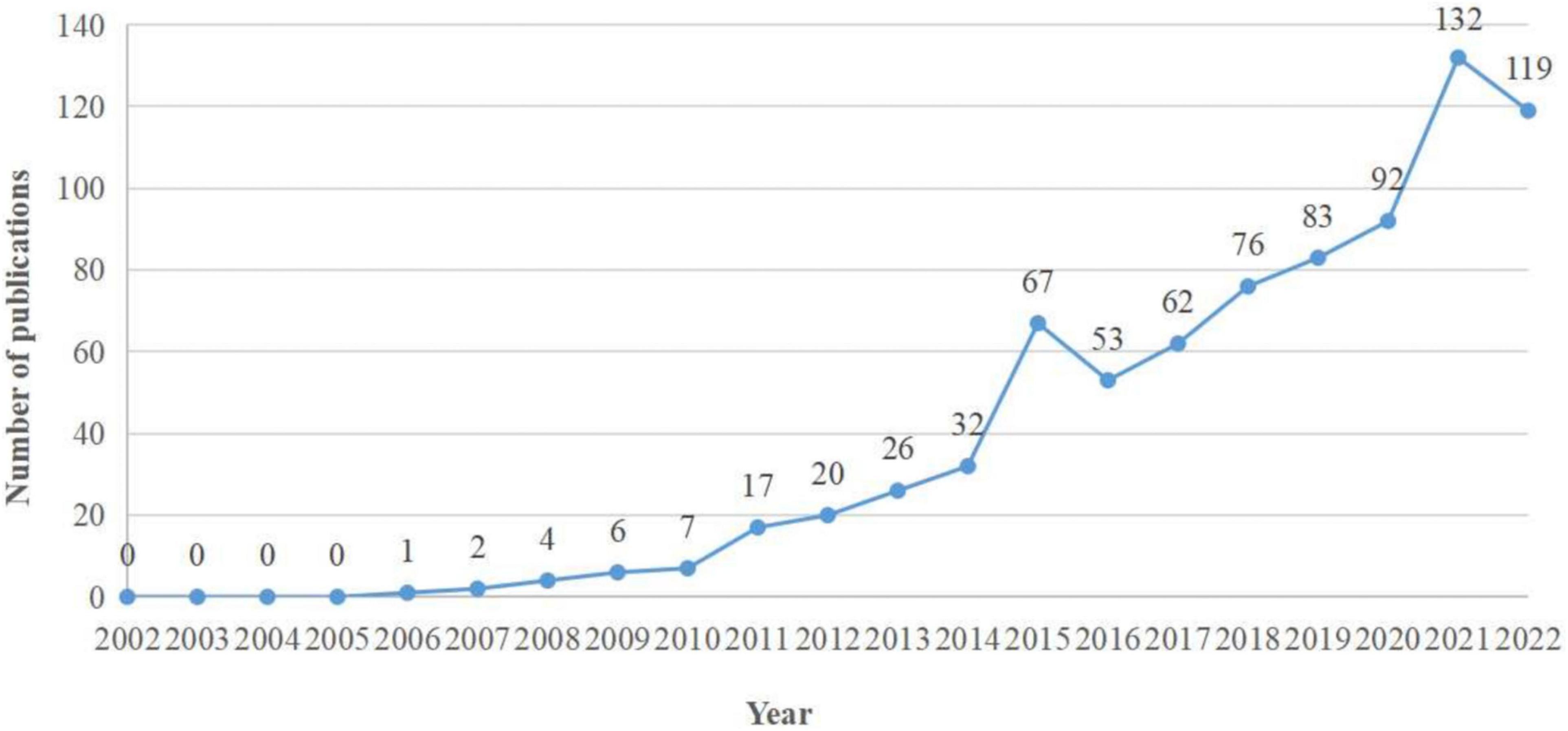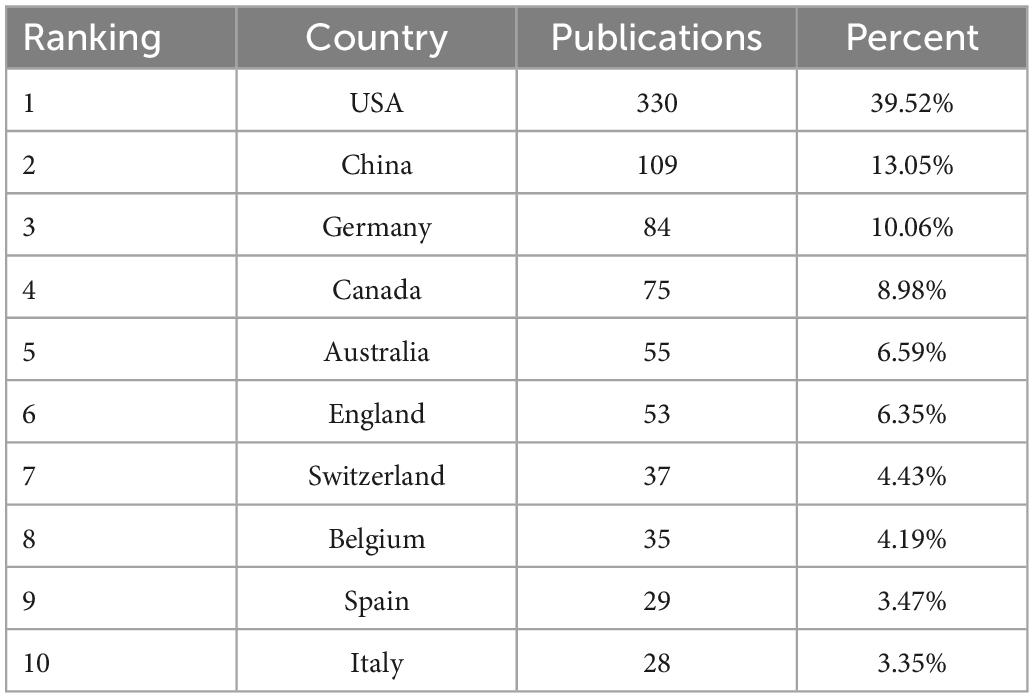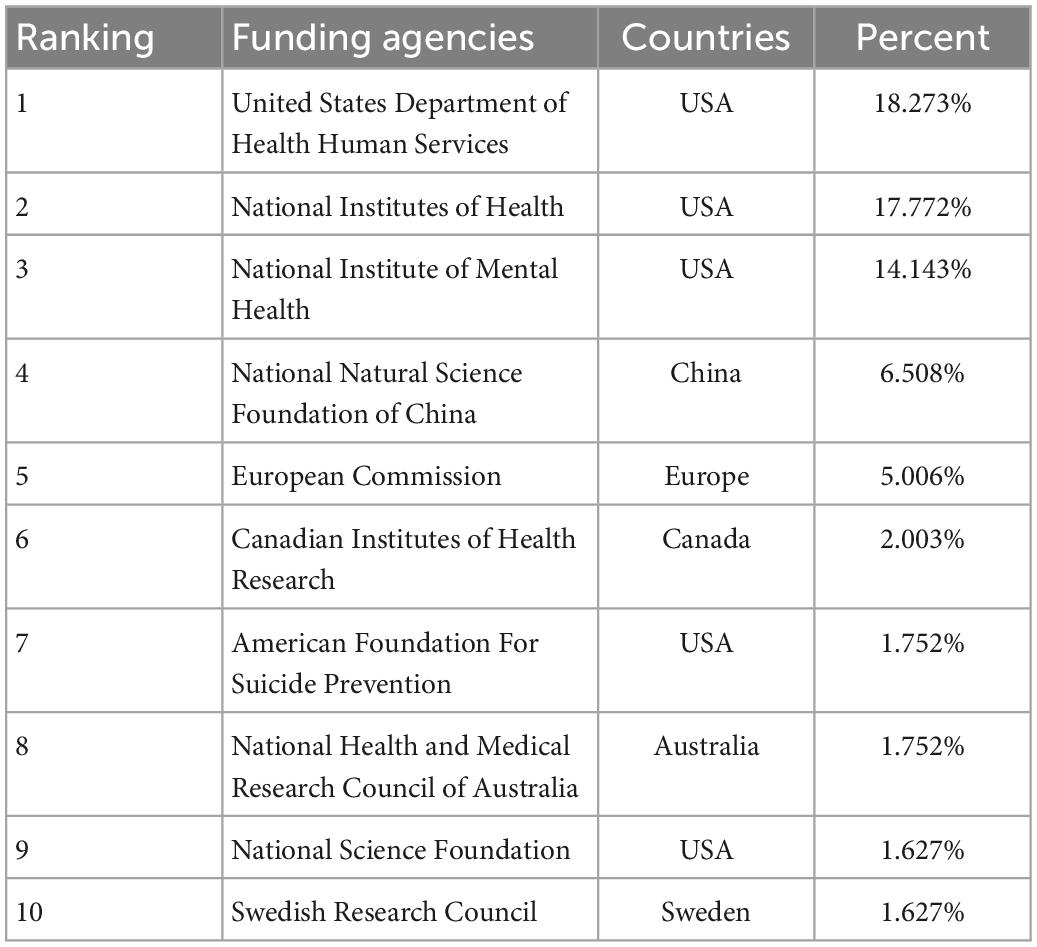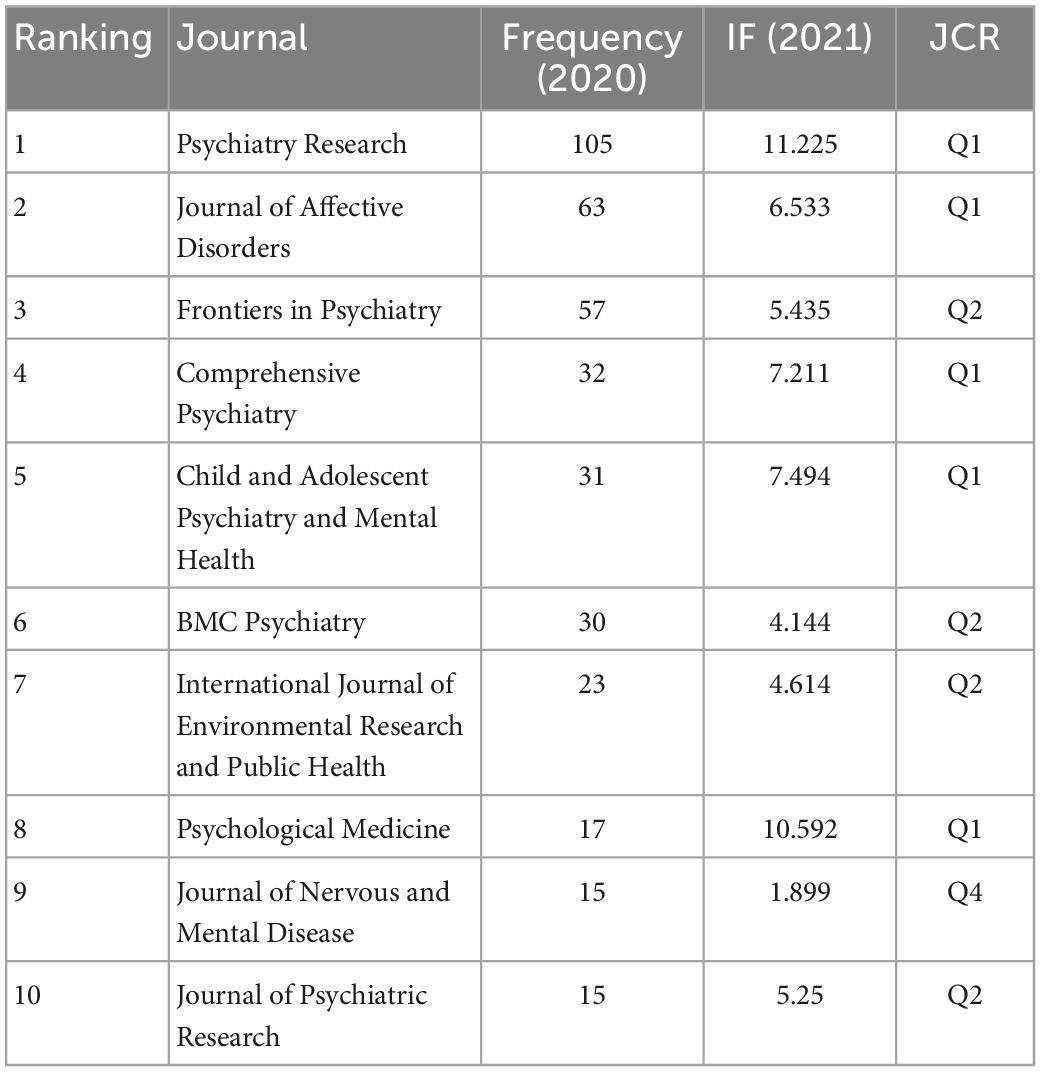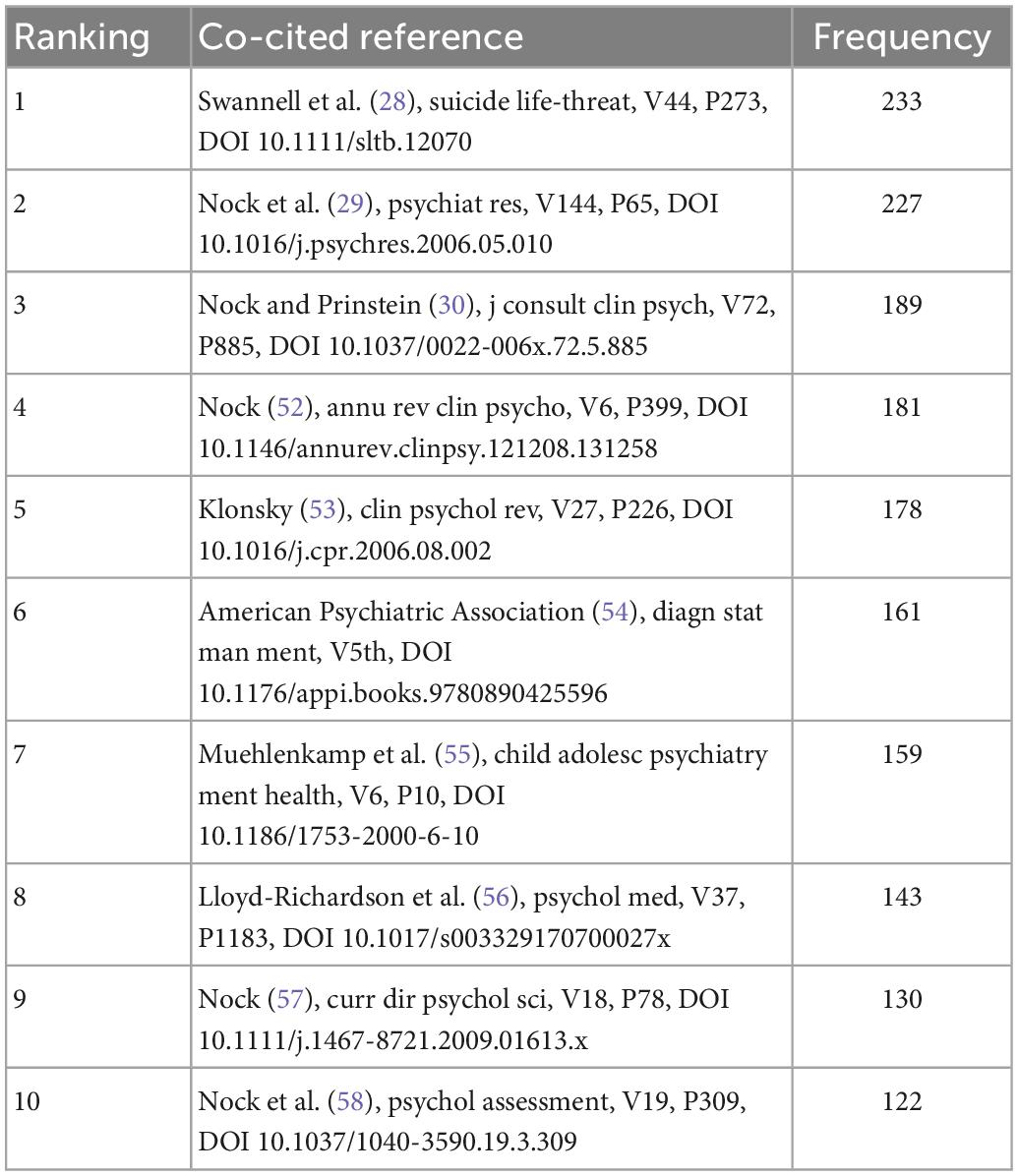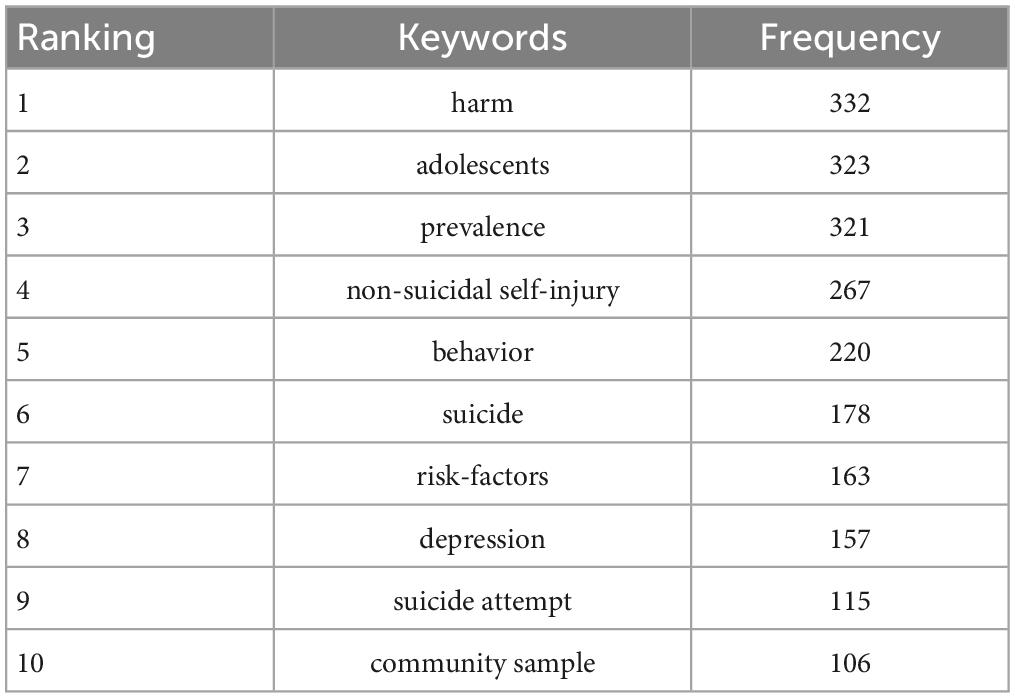- 1Department of Psychosomatic Medicine, The Second Affiliated Hospital of Nanchang University, Nanchang, China
- 2Jiangxi Medical College, Nanchang University, Nanchang, China
- 3Department of Rehabilitation Medicine, The First Affiliated Hospital of Nanchang University, Nanchang, China
- 4Department of Psychosomatic Medicine, The First Affiliated Hospital of Nanchang University, Nanchang, China
- 5Department of Rehabilitation Medicine, Jiangxi Provincial People’s Hospital, Nanchang, China
- 6Department of Rehabilitation Medicine, Zhujiang Hospital of Southern Medical University, Guangzhou, China
Objective: To overview the research actuality and offer the hotspots and cutting-edge issues in the field of Non-suicidal Self-injury (NSSI) by using bibliometric analysis.
Materials and methods: Publications related to NSSI from 2002 to 2022 were extracted from the Web of Science Core Collection (WoSCC) database. CiteSpace V 6.1.R2 and VOSviewer 1.6.18 were used to visually analyzed institutions, countries, journals, authors, references, and keywords in research on NSSI.
Results: A total of 799 studies about NSSI were analyzed via CiteSpace and VOSviewer. The number of annual publications related to NSSI is fluctuating growth. The USA and Harvard University are the most productive country and institutions. In the case of journals and co-cited journals, Psychiatry Research are the most productive journal and also ranked highest among co-cited journals. Furthermore, Michael Kaess has published the most publications, and Matthew K. Nock is the most cited author. An article published by Swannell SV et al. shows the highest citation counts. After analysis, the most common keywords are harm, adolescents and prevalence. The gender difference, diagnosis, and dysregulation are frontier areas of NSSI research.
Conclusion: This study analyzed the research of NSSI from multiple perspectives, and provides valuable information for researchers to capture the current status, hot spots, and frontier trends of NSSI.
1. Introduction
Non-suicidal Self-injury (NSSI) is described as deliberate, direct destruction or alteration of body tissue without conscious suicidal intent (1). This includes any behave that maybe cause harm but not death to oneself, such as cutting, burning, scratching, and impingement (2). A study on NSSI have pointed out that an increasing trend globally, including in developing countries and it is almost equally prevalent in both developing and developed countries (3). A large number of studies has confirmed that NSSI is motivated by intrapersonal/self-regulating and interpersonal/social functions (3). Even people who show only one or two acts of NSSI admit at least one function for their act, and the intrapersonal function is the most common (4). NSSI has become a common mental health threat among people, the prevalence of NSSI is 46.5% in adolescents and 23% in young adults (5). There has high number of clinical assessment instruments and diversity of evaluations about NSSI research, the most frequent instruments of NSSI are structured interviews and their indicators were related to NSSI function and topography (6).
Many patients with non-suicidal suicide don’t take it seriously without treatment and eventually evolve into other psychiatric disorders such as borderline personality disorders (BPD), anxiety disorders, and affective disorders (7). The therapies of NSSI that were identified as effective were cognitive behavioral therapy, dialectic behavioral therapy for adolescents (DBT-A), and mentalization-based therapy for adolescents (MBT-A) (8). Furthermore, in recent study the cognitive behavior hypnotherapy was found to be effective in treating the non-suicidal self-injury condition (9).
Bibliometrics is a mathematical and statistical method that analyzes and observes research trends and is widely applied in many fields (10). It plays an important role in developing guidelines and understanding research hotspots. We can quickly clarify the structure of literature, analyze the development process, and capture the research hotspots of research fields by using bibliometrics analysis (11). This study aimed to use CiteSpace and VOSviewer scientific softwares to analyze literatures related to NSSI over the past 20 years and explore its research hotspots and development trends, and also to provide a thinking direction for future research.
2. Materials and methods
2.1. Data sources
The retrieval data were extracted from the Science Citation Index-Expanded of Web of Science Core Collection (WoSCC). The WoSCC is the most frequently used and acceptable database for scientific or bibliometric studies. It contains nearly 9,000 of the world’s most prestigious high-impact journals and more than 12,000 academic conferences (12), so we selected it to perform the search. Relevant publications were downloaded within 1 day on December 4, 2022. The process of data extraction was presented in Figure 1. The search strategy was [TI = (non-suicidal self-injur* OR non-suicidal self-injur* OR non-suicidal self-harm* OR “NSSI”) OR AK = (non-suicidal self-injur* OR non-suicidal self-injur* OR non-suicidal self-harm* OR “NSSI”)]. To capture as many data sources as possible, the wildcard character (*) that could be substituted for any other characters and allows variable endings of keywords was used (13). For example, “non-suicidal self-injur*” would also return the terms of “non-suicidal self-injury” and “non-suicidal self-injurious.” The dates of the search restricted from January 1, 2002, to December 4, 2022, resulting in 1,658 records. This was followed by 220 unrelated document types, including conference abstracts, editorial material, corrections, correspondence, retractions, and conference proceedings, and 1,438 results were remaining. Then, restricting language as English there left 1,406 results. Next, two independent investigators reviewed the titles and abstracts and excluded articles that were not associated with NSSI, eventually 799 publications were remained.
2.2. Analysis tool
All search datas retrieved WOSCC were converted to VOSviewer and CiteSpace to perform visual analysis.
VOSviewer is a computer program developed by Van Eck and Waltman at Leiden University in the Netherlands in 2009 that is suitable for constructing complex networks using large-scale data (14). It provides visual analysis and creates maps based on network data. It can construct network diagrams of academic publications, scientific journals, authors, research institutions, countries, and keywords. The items in these networks can be connected by co-citation links, co-occurrence, citation, and bibliographic coupling (15). Each node of the network maps represented elements such as country, institution, or keyword, the size and color of the nodes reflected frequency and cluster of elements, respectively (16). The links between nodes represented the co-authorship, co-citation or co-occurrence associations between nodes and the color of the nodes and lines indicated different clusters or corresponding average appearing year (AAY) (17). We use VOSviewer to analyze institution, co-cited journals, authors, co-cited authors and keywords. VOSviewer software parameter settings: Normalization Method: association strength; the minimum publication thresholds for institutions and authors are all 5, respectively; the minimum citation thresholds for journals, authors, and references are 100, 100, and 50, respectively; and the minimum keyword occurrence threshold is 15 (18).
CiteSpace is created by Dr. Chaomei Chen (School of Information Science and Technology, Drexel University, Philadelphia, PA, USA) and his team in 2004 (11). Burst detection, betweenness centrality, and heterogeneous networks are three central concepts of CiteSpace, which help to quantitatively and visually summarize previous research, and identify trends and key change nodes in a timely manner. We used CiteSpace to analyze institution, countries, dual-map overlay of journals and strongest citation bursts of references and keywords. We downloaded the records retrieved by WoSCC, and then converted these data into plain text format for export, including complete records and references, which was named download_ XXX. txt, and finally imported into citespace (V.6.1.R2) for bibliometric and visual analysis (19). The specific parameters used in CiteSpace were set as follows: time span (from January 1, 2004 to December 31, 2022, year per slice = 1), top N (50), term source (title, abstract, author keywords, and keywords plus), node types (author, institution, country, keywords, cited reference, cited author, and cited journal), network clipping method (pathfinder) (20). The remaining settings maintain the software default. Different nodes in a map represented indexes including a country and institution, or journal. The size of the nodes spoke on behalf of the centrality of publications or frequency, and a node with large size typically indicated high occurrence or citation frequency as a pivotal point, meanwhile, the links between nodes showed the network of cooperation, collaboration, or co-citation, and the color of nodes and links indicated different clusters (21).
3. Results
3.1. Analysis of publication years
The number of publications per specific period reflects the development trend of research in this field (Figure 2; 14). As shown in Figure 2, From 2002 to 2010, publication outputs during this period were low, the research on NSSI had a slow development speed. Since 2011, the number of publications has gradually increased, reaching 132 publications output in 2021, indicating that NSSI is receiving increasing attention.
3.2. Analysis of institutions
A total of 346 institutions involved in the publications about NSSI and the top 10 productive institutions are listed in Table 1. Harvard University (n = 40) has the most publications, followed by Heidelberg University (n = 31) and Katholieke University Leuven (n = 27). The network map of institution cooperation was generated by CiteSpace (Figure 3), in which each node represents an institution and the size of the node indicates the number of publications by the institution. The bigger the size of nodes is, the more publication output of institution is. Besides, the purple outer ring of the circle is centrality, the wider the circle, the higher is the centrality (22). It can be seen that there were relatively few collaborations among institutions from different countries, only three institutions including Harvard University (centrality: 0.34), Harvard Medical School (centrality:0.26) and Katholieke University Leuven (centrality:0.14) had the value of centrality more than 0.1. The institution co-authorship analysis was generated by VOSviewer (Figure 4). According to the color gradient in the lower right corner, these institutions such as Duke University and University of Notre Dame were given a red color with the larger AAY values, University of Wisconsin System is given a green color with the smaller AAY values (17).
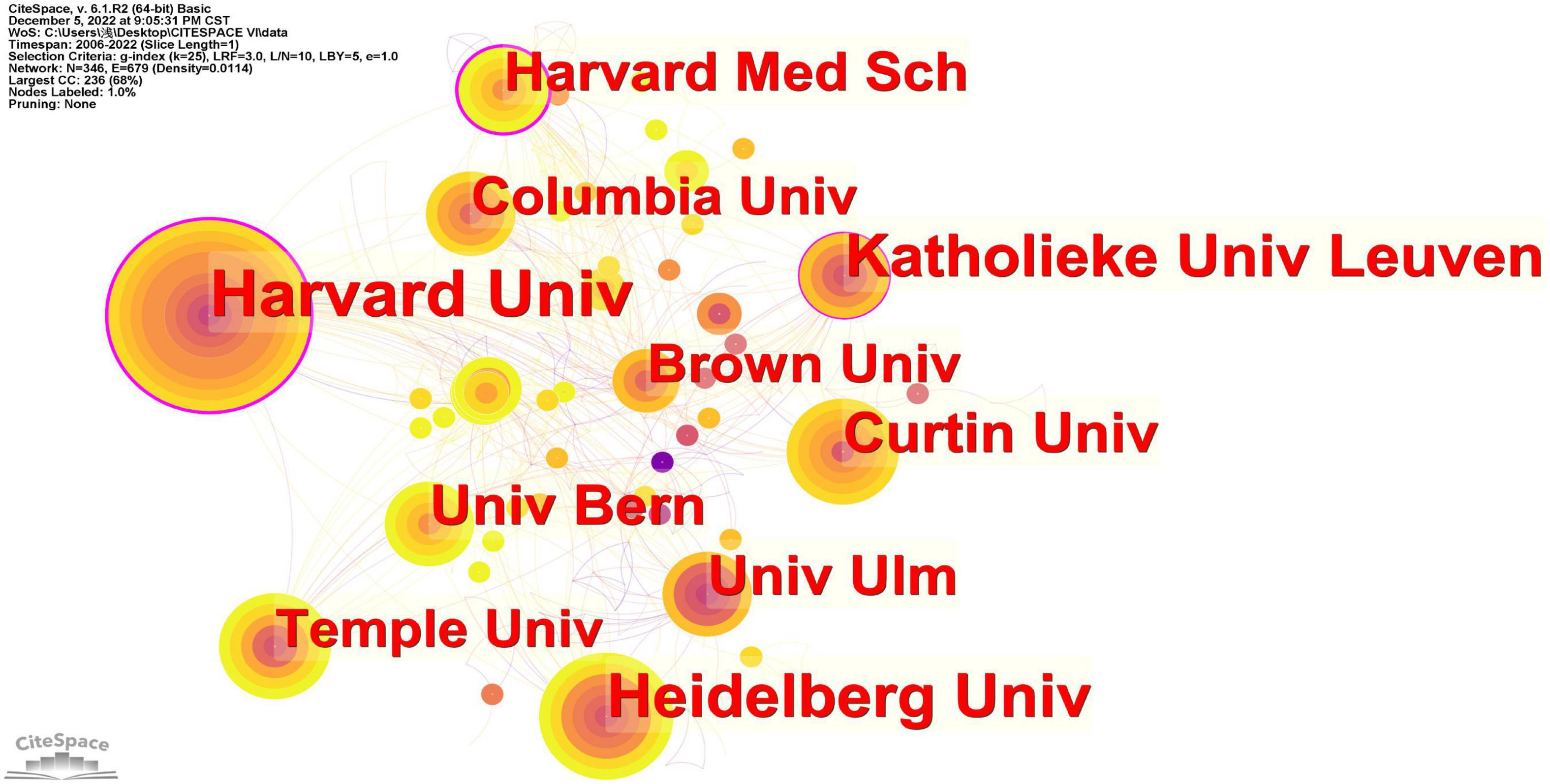
Figure 3. An institution cooperation map related to non-suicidal self-injury (NSSI) research by CiteSpace. The larger circle is, the more publications output of institution is; the links between nodes showed the network of cooperation, the denser the link, the more cooperation of institution is.

Figure 4. The overlay visualization of institutions generated by VOSviewer. The color of the nodes and lines indicated corresponding average appearing year of institution.
3.3. Analysis of countries and funding agencies
According to statistics, a total of 799 articles related to NSSI were published in 50 countries. The top 10 countries are listed in Table 2. The United States had the most publications (n = 330), followed by China (n = 109) and Germany (n = 84). This phenomenon may be related to the population of the countries. The larger the population, the greater the number of psychological problems associated with NSSI, which can arouse the attention of clinical workers and researchers. The country cooperation map was conducted CiteSpace (Figure 5), in which each node represents a country, and the size of the node is proportional to the number of articles published by country. Links between nodes signify relationships of collaboration or co-occurrence or co-citation among countries (23). The figure shows the close cooperation between the USA and other countries including Belgium, Australia, and Germany etc. Besides, The USA leads in both single-country and multi-country publications among different countries. It’s worth noting that Italy’s centrality is 0, which indicates Italy has relatively few collaborations with other countries. In Table 3, top 10 funding sources in the field of NSSI research are listed. summarizes the data of the top 10 most frequent funding sources in this field. Obviously, the United States has a large percentage, with five funding agencies in the United States. The USA also published the most relevant articles, it is apparent that the wealth of different countries can influence research in certain degree.
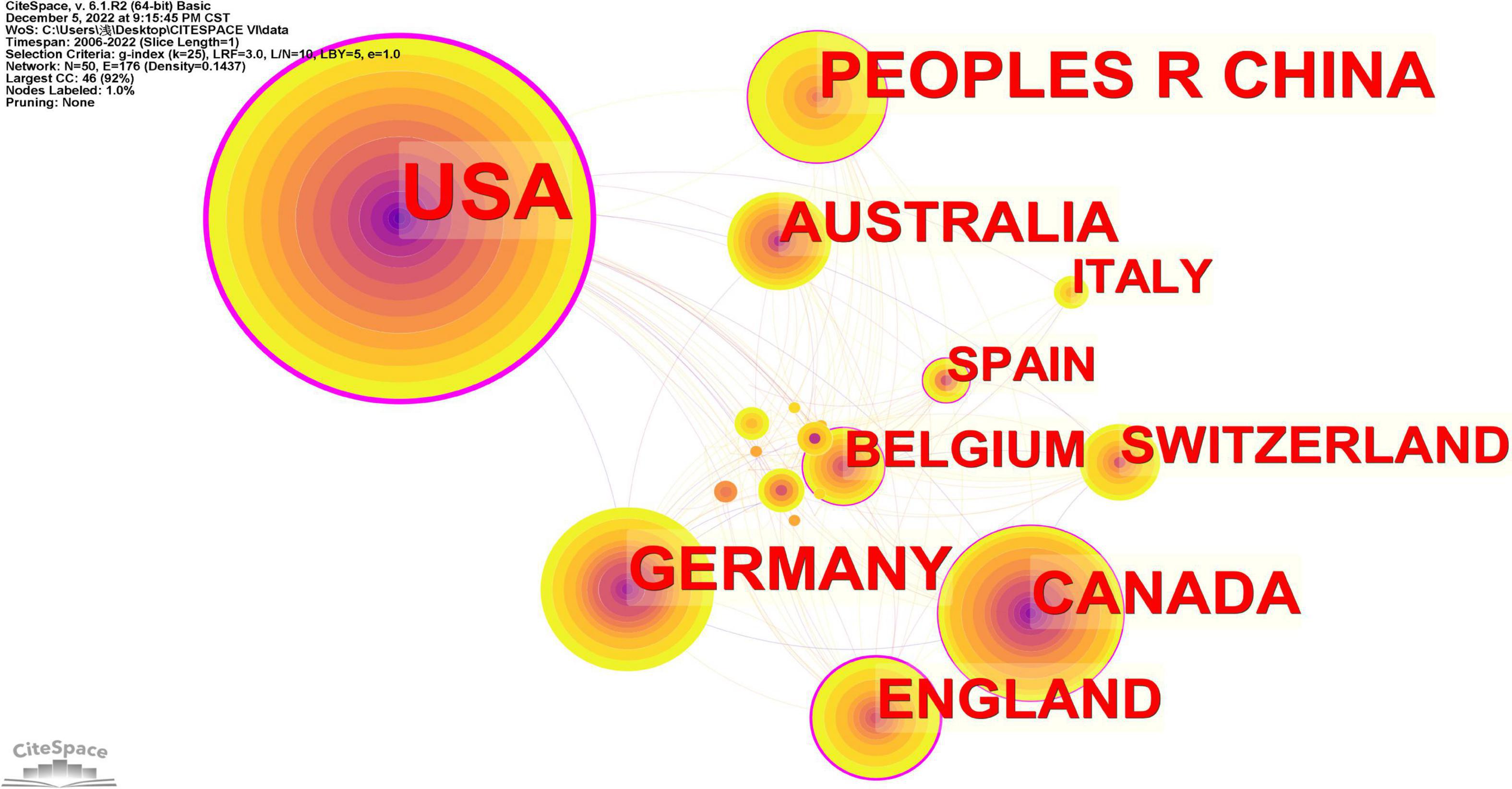
Figure 5. A country cooperation map related to non-suicidal self-injury (NSSI) by CiteSpace. The large node is, the more publications output of countries is.
3.4. Analysis of journals and cited journals
To find the core and authoritative journals in the field of NSSI, we conducted the analysis of literature sources (24). The top 10 journals are shown in Table 4. The first was Psychiatry Research (n = 105), followed by journal of affective disorders (n = 63) and frontiers in psychiatry (n = 57). The highest impact factor journal was the Psychiatry Research (IF = 11.225, JCR = Q1), and the average of 10 journals’ impact factor was approximately 6.44. The network visualization map of journal co-citation analysis was generated by VOSviewer (Figure 6). Only journals with a minimum of 100 citations were visualized and 75 journals satisfying the criteria, the most frequency co-citations is Psychiatry Research, followed by Suicide And Life-threatening Behavior and Journal Of Affective Disorders.
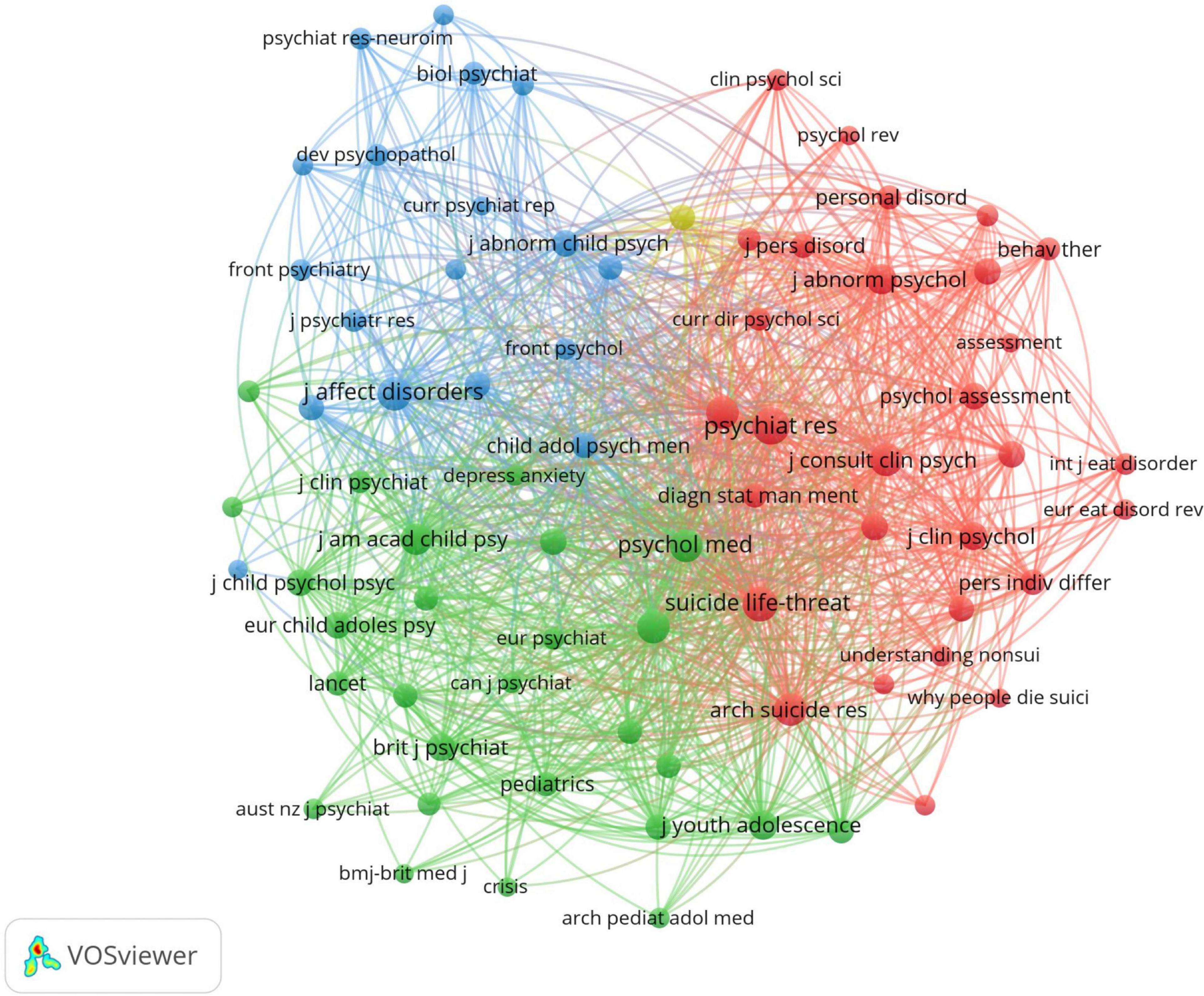
Figure 6. Network visualization map of journal co-citation analysis generated by VOSviewer. Each node represents a co-citation journal and each color represents one cluster, the links between nodes represents co-citation of journals.
The dual-map overlay of journals is shown in Figure 7. The left side represents the citing journals and the right side represents the cited journals. Those colored lines start from the left and end at the right presenting a co-citation relationship. From the figure, we can found that one main citation path. The publications related to NSSI were published in the journals of psychology, education, and health, but the most cited publications were published in the journals of psychology, education, and social.
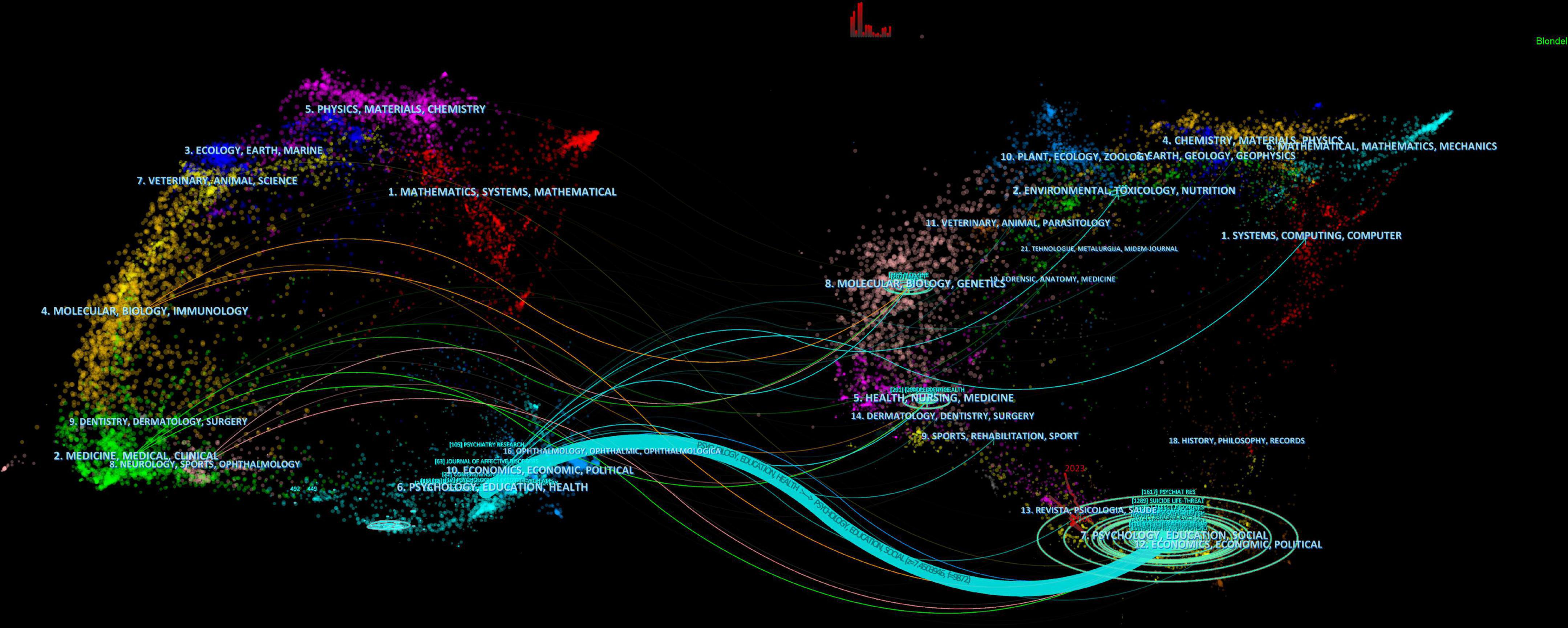
Figure 7. The dual-map overlay of journals contributed to publications on non-suicidal self-injury (NSSI) by CiteSpace. The left side represents the citing journals and the right side represents the cited journals.
3.5. Analysis of authors and cited authors
A total of 445 authors published related articles on NSSI. As shown in Figure 8, the author’s authorship was conducted by VOSviewer. Each color represents a cluster, there were 21 clusters in figure. Active collaborations usually exist in the same cluster, such as Michael Kaess and Peter Parzer; there were also collaborations among linked two nodes in different clusters, such as Matthew K. Nock and Laurence Claes (25). Besides, some clusters has no collaboration with others, which indicated further cooperation with authors in the field of NSSI. The top 10 related authors and co-citation are listed in Table 5. The most productive author was Michael Kaess, who contributed 35 publications, followed by Franz Resch (n = 26) and Paul L. Plener (n = 23). Co-cited author analysis refers to when the literatures of two authors are simultaneously cited by a third author. The visualization density map of co-citation author’s analysis was generated by VOSviewer (Figure 9), in which 43 authors were cited at least 100 times. We could clearly view the high-frequency co-cited authors, the deeper the color, the more citations. The highest frequency co-citation author is Matthew K. Nock, followed by E. David Klonsky and Jennifer J. Muehlenkamp.
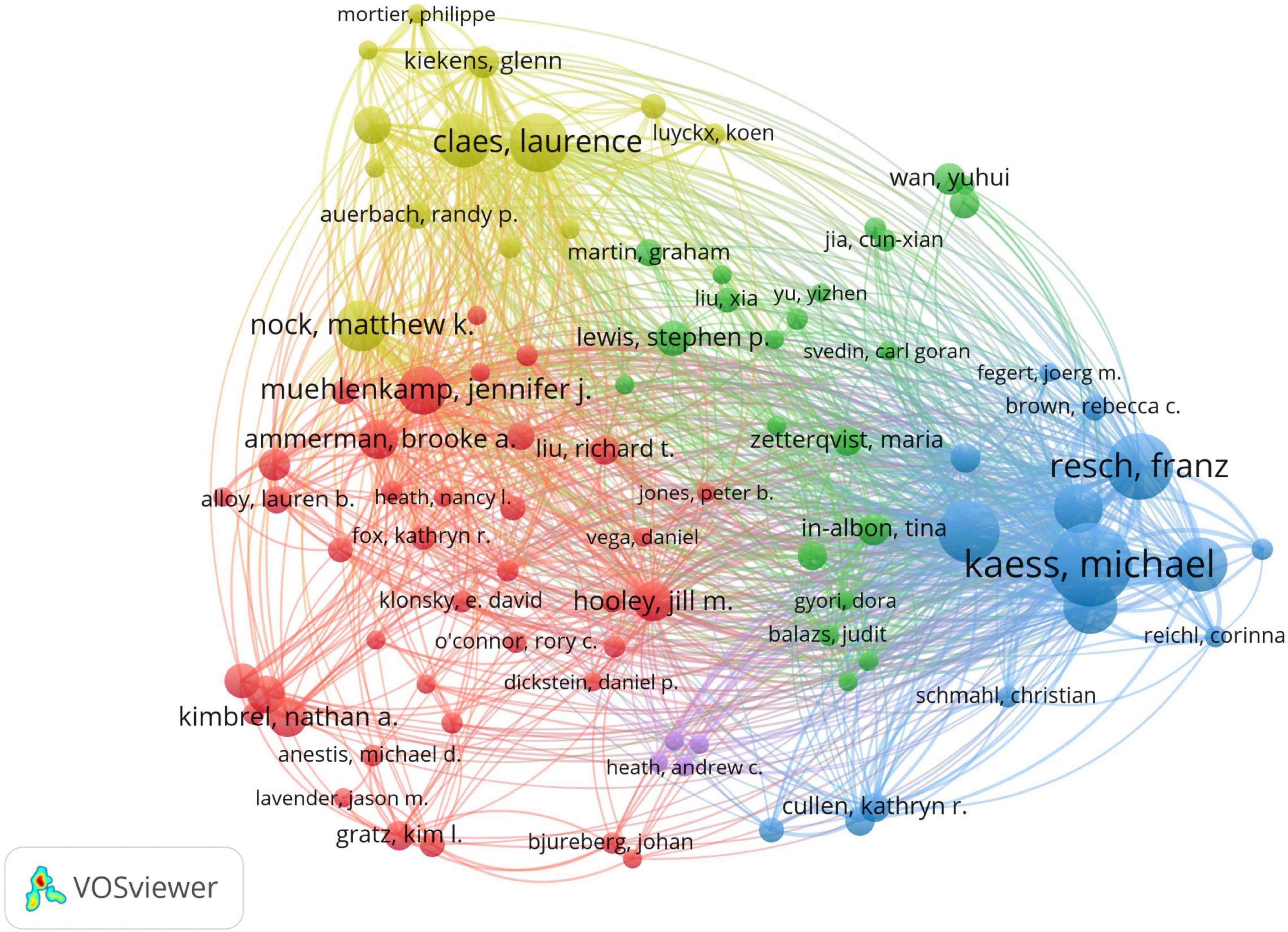
Figure 8. Network visualization map of authors generated by VOSviewer. Each node represents an author and each color represents one cluster, the links between nodes represents cooperation of authors.
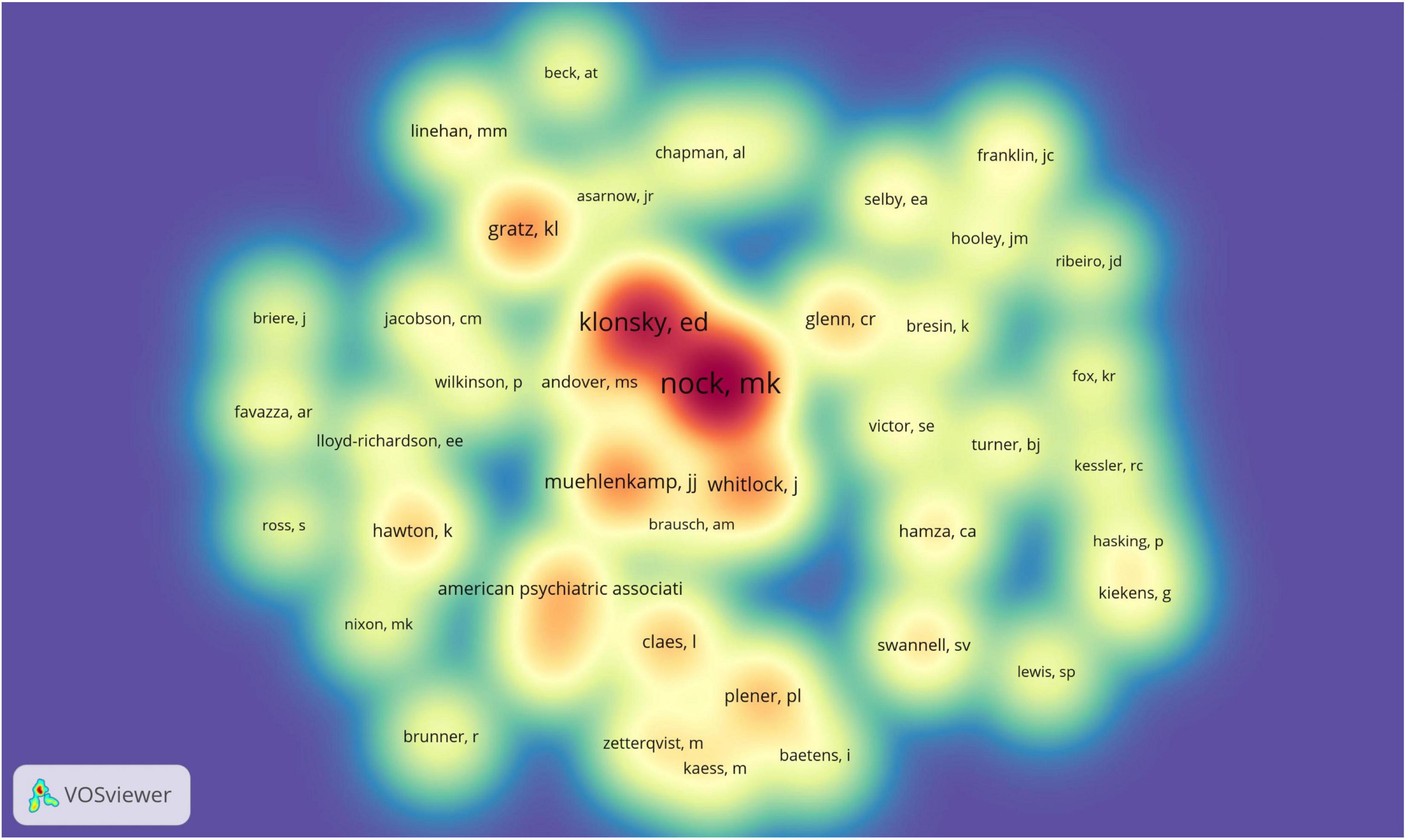
Figure 9. The density map of co-citation authors generated by VOSviewer. The deeper of color, the more representative authors is.
3.6. Analysis of co-cited references
Co-cited references are references that have been co-cited in a set of publications (26, 27). Usually cited references with the highest frequency are the main focus of the researchers. The top 10 co-cited references related to NISS are listed in Table 6, and each of them was co-cited more than 90 times. The first co-cited reference was published by Swannell SV et al., which investigated the methodological factors affecting heterogeneity in estimates of prevalence of NSSI, the time effects, and overall international NSSI prevalence (28). The second co-cited reference was published by Matthew K. Nock et al. In 2006, which reported on the diagnostic correlates of adolescents with a recent history of NSSI and examines the relation between NSSI and suicide attempts (29). The third co-cited reference was published by Matthew K. Nock et al. in 2004, which this study applied a functional approach to the assessment of self-mutilative behavior among adolescent psychiatric inpatients (30). The network map of co-cited references timeline view was conducted by CiteSpace (Figure 10), which displays the evolution of research hotspots over time. Clusters were formed by selecting keywords, and then a total of 11 clusters were generated by LLR algorithm; each of these clusters represents the activity of its future direction, the denser and more active the clusters in the graph, the more they represent the current research frontier (31). The elements on the horizontal axis represent co-cited references; the position of the element on the horizontal axis denotes the time of the first occurrence; and the line connecting the elements denotes the co-cited relationship. The size of the element is proportional to the citation count of the reference (32). As shown in Figure 10, cluster #0 (community sample), #8 (diagnostic correlate) and #9 (sexual abuse) started earlier; while cluster #4 (eating disordered behavior), and #6 (non-suicidal self-injury) are still continuous, which could be regarded as the frontier.
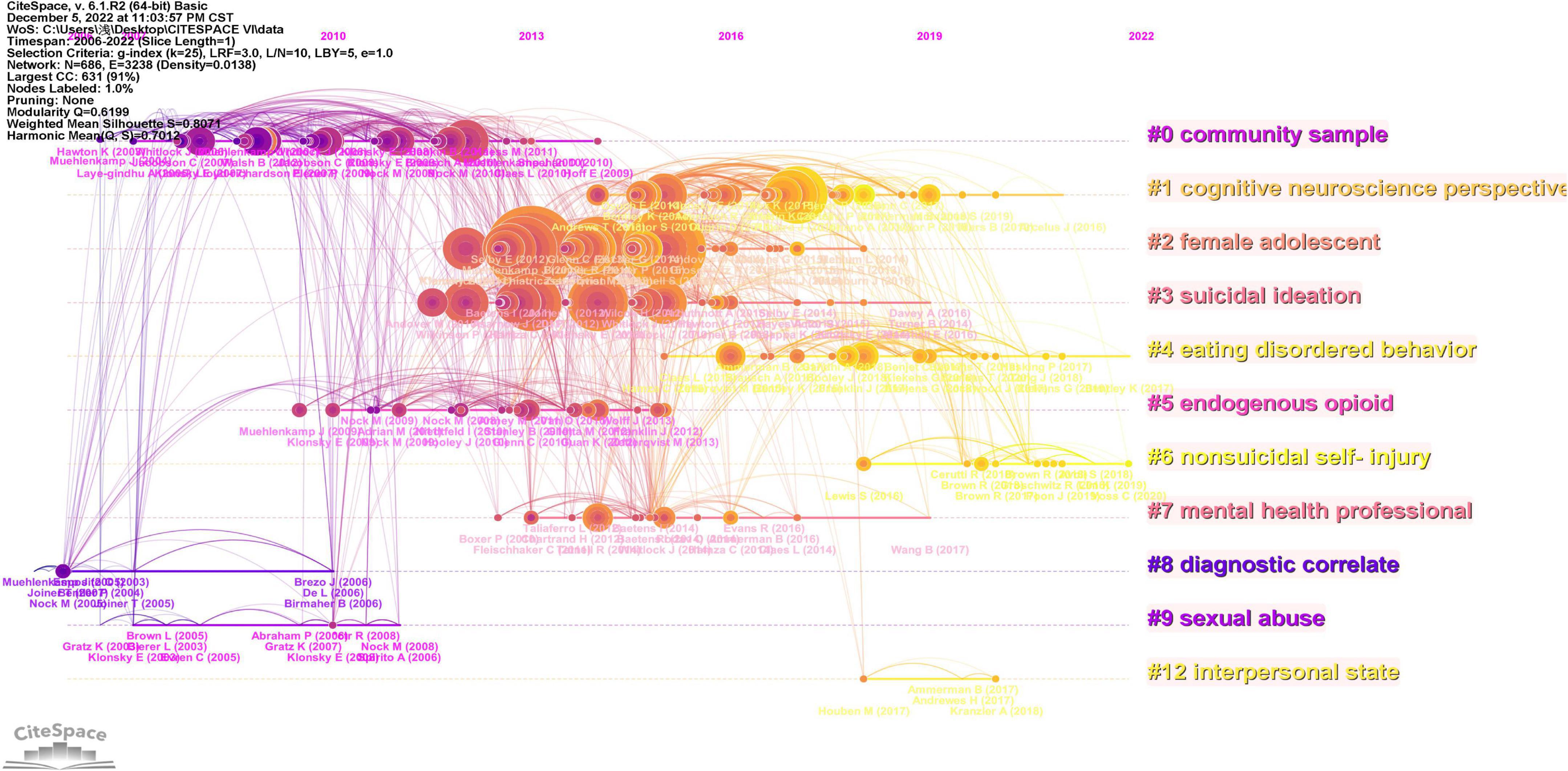
Figure 10. The network of co-cited references timeline viewer by CiteSpace. Each horizontal axis is one cluster, the denser the clusters are, the more they represent the frontier in the field of non-suicidal self-injury (NSSI).
References with citation bursts are those that have been cited significantly more frequently over a period (33). The years between “Begin” and “End” represent the period when the reference was more influential; years in light green mean that the reference has not yet appeared, years in dark green mean that the reference is less influential, and years in red mean that the reference is more influential (34). The top 25 references with the strongest citation bursts were generated by CiteSpace (Figure 11). The strongest burstness (strength = 27.35) occurred in a paper entitled “Prevalence of Non-suicidal Self-Injury in Non-clinical Samples: Systematic Review, Meta-Analysis and Meta-Regression”(28), published in Suicide Life Threat Behave by Sarah V Swannell et al. in 2014 with citation burstness from 2016 to 2019. Notably, five references (4, 5, 8, 35, 36) were still in burstness. Respectively, J D Ribeiro et al. (35) aimed to examine the magnitude and clinical utility of the associations between self-injurious thoughts and behaviors and subsequent suicide ideation, attempts, and death; G. Kiekens et al. (36) aimed to evaluate whether NSSI is associated with increased odds of subsequent onsets of suicidal thoughts and behaviors (STB) independent of common mental disorders, whether NSSI is associated with increased risk of transitioning from suicide ideation to attempt, and which NSSI characteristics are associated with STB after NSSI; Rebecca C. Brown et al. (8) reviewed the current literature on epidemiology, etiology, and therapeutic approaches with a focus on the period of adolescence; Peter J. Taylor et al. (4) conducted a systematic review and meta-analysis of the prevalence of NSSI functions in community and clinical samples; Annarosa Cipriano (5) reviewed non-suicidal, self-injurious behaviors.
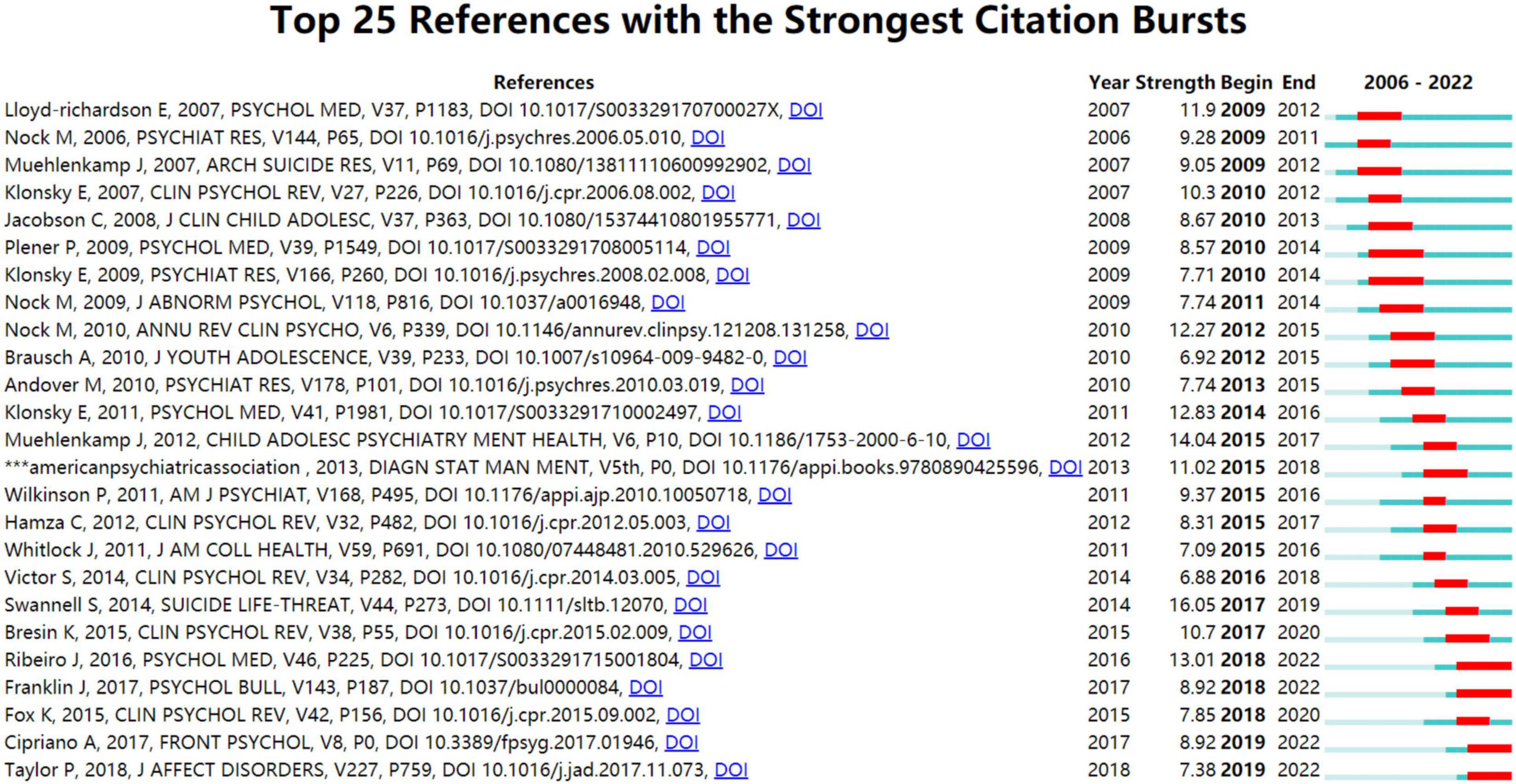
Figure 11. Top 25 references with the strongest citation bursts generated by CiteSpace. The blue line is the time interval, the red line is the time period with reference bursting.
3.7. Analysis of keywords
A total of 484 keywords were extracted from literature about NSSI. 10 keywords were listed in Table 7. The most frequency was “harm” (n = 332), followed by “adolescents” (n = 323), “prevalence” (n = 321), “non-suicidal self-injury” (n = 267) and “behavior” (n = 220). The network of co-occurrence keywords was generated by VOSviewer (Figure 12), in which 97 keywords occurrence at 15 times. The keywords formed four clusters: cluster 1 (red color), cluster 2 (blue color), cluster 3 (yellow color), cluster 4 (green color), which were differentiated by color in the diagram, with the same color being the same cluster; the keyword size indicated the number of occurrences of the keyword, whereas the thickness and distance of the connecting lines between the keywords indicated the frequency of co-occurrence between the two keywords (37). The overlay visualization of keywords was generated by VOSviewer (Figure 13), where the color indicated the average published year. As we can see, ecological momentary assessment, dysregulation and gender difference are emerging fields that were colored yellow (17).
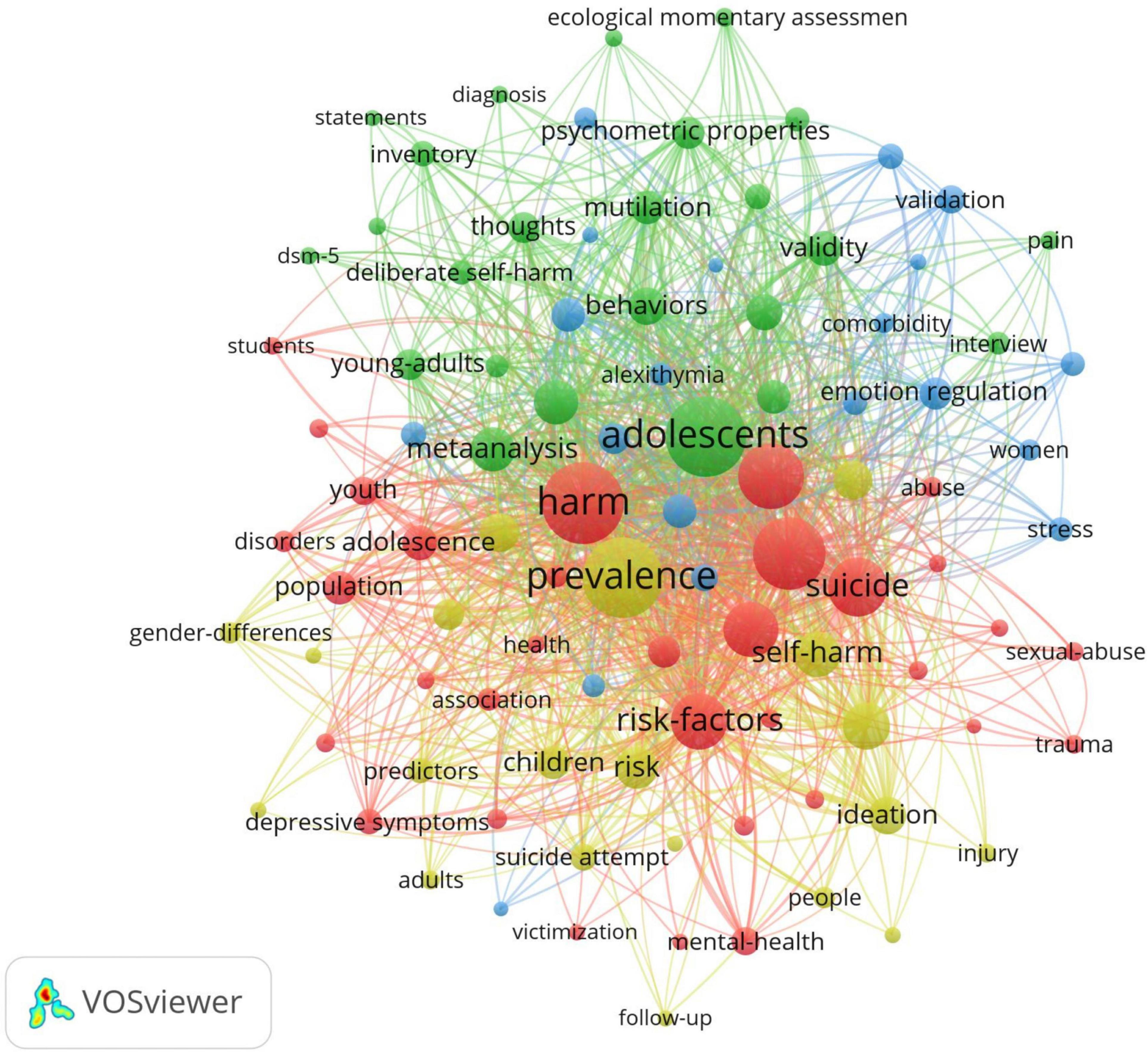
Figure 12. Keywords cluster analysis co-occurrence map generated by VOSviewer. Each node represents a keywords and each color represents one cluster, the links between nodes represents c0-occurrence of keywords.
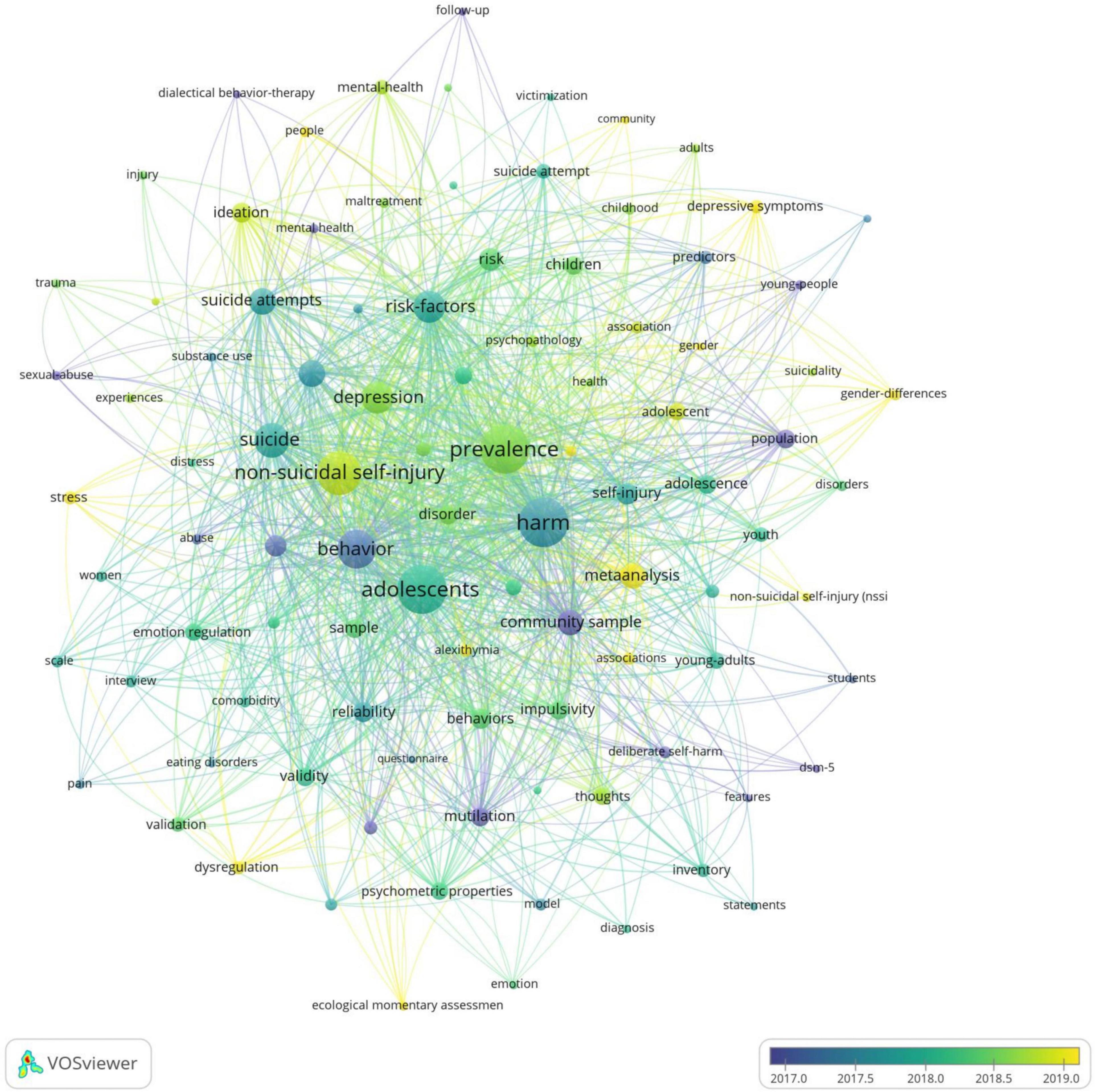
Figure 13. The overlay visualization of keywords generated by VOSviewer. The color of the nodes and lines indicated corresponding average appearing year of keywords.
The burst detection in Citespace, based on Kleinberg’s algorithm, aims to figure out a meaningful document flow structure with respect to time lapse. Keywords bursts provide helpful insight into the research footprint of the research focus (38). The top 25 keywords with the strongest citation bursts were generated by CiteSpace (Figure 14). The blue line means the time interval, while the red line means the time period with a keyword bursting (26). “mutilation” had the strongest burst (strength = 13.39) from 2008 to 2016. Notably, “gender difference” (strength = 5.56), “diagnosis”(strength = 3.41), “dysregulation” (strength = 2.58) are still in burstness, they are considered as frontier in the field of NSSI research.
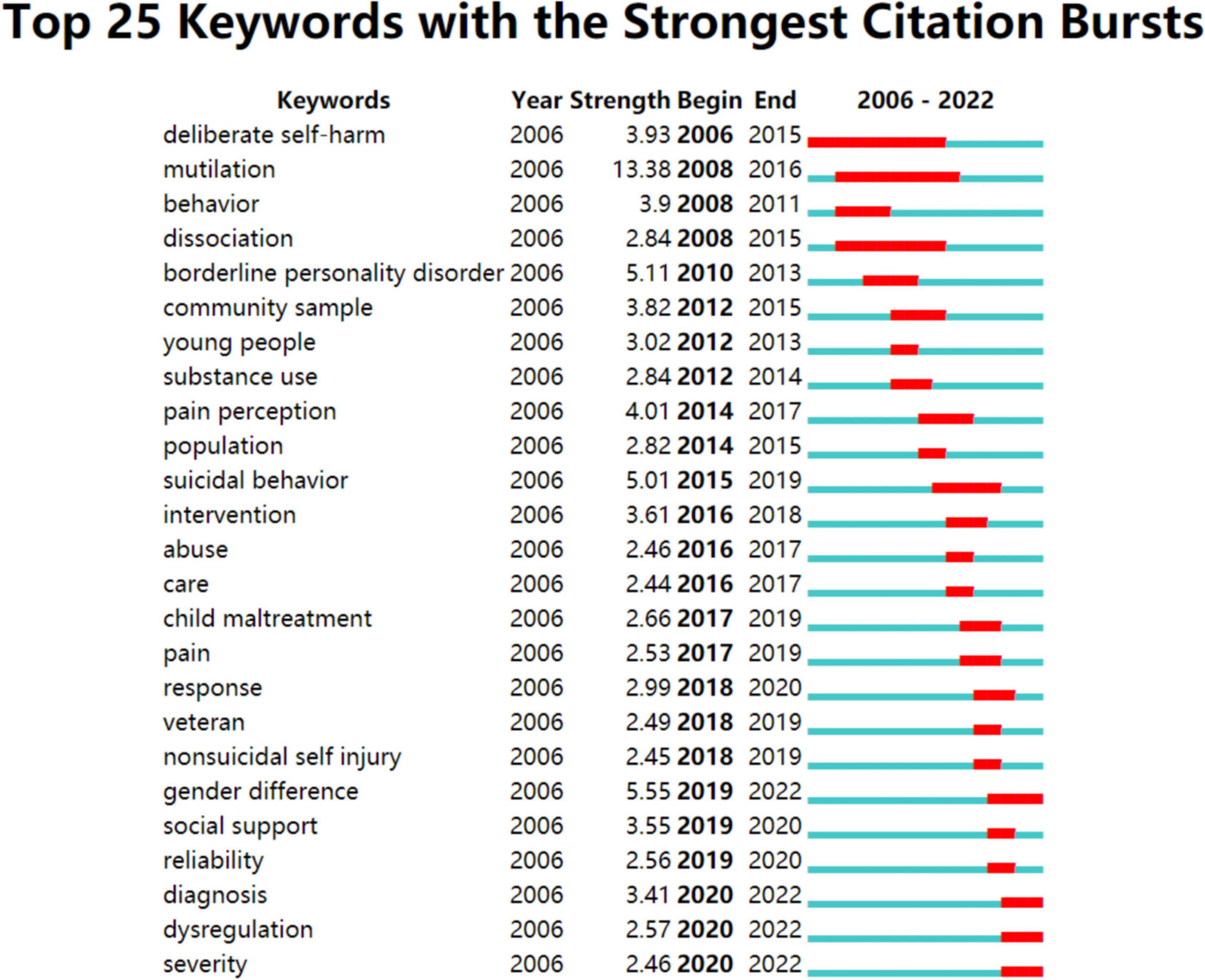
Figure 14. Top 25 keywords with the strongest citation bursts generated by CiteSpace. The blue line is the time interval, the red line is the time period with a keyword bursting.
4. Discussion
In this article, we used CiteSpace and VOSviewer to visually analyze studies on NSSI from 2002 to 2022, which aimed to help researchers grasp developmental trends in this field. 799 publications related to NSSI were searched from the WoSSC.
• As shown in Figure 2, the number of publications related to NSSI shows slightly fluctuated growth. There were small numbers of publications in this field that began to appear from 2002 to 2010, but in the meantime, however, this research is still in its infancy (28). Since 2011, the number of publications began to rapidly increase, it can be seen that the NSSI research is got more attention. Overall, the number of publications is up which represents NSSI research will has good development trend in the future.
According to the analysis of countries in Figure 5, the USA was the most productive country and the number of publications overwhelmingly exceeded other countries. It is inseparable from the local funding agencies (27). Among the top 10 funding agencies, five were from the USA and it shows the strong academic impact of the USA on the research related to NSSI. As shown in Table 1, five institutions were from the USA, and Harvard University shows the highest centrality (0.34), which indicates it plays a pivotal part in bridging cooperation among institutions worldwide.
Furthermore, according to the top 10 authors in Table 5, Michael Kaess from the Heidelberg University contributed the most publications. But Mattew K. Nock had the most value of centrality (0.32), which shows he played a vital leadership role in this field and it is worthwhile for novice researchers in this field to deeply research his publications. As for co-cited authors, the publications of five authors were cited more than 400 times and Matthew K. Nock (n = 1,412) had the highest number of citations. Significantly, Michael Kaess had the most significant number of published articles without ranking in top 10 cited journals, whereas Mattew K. Nock published articles far lwss than Michael Kaess could listed first in co-citation journals. Therefore, it can be seen that we should not only pay attention to the number of articles, but also the quality of articles, and improve the impact of the research in the future.
As shown in Table 4, the journal with the most articles about NSSI was the Psychiatry Research (n = 105, IF = 11.225) and there is only two journal’s impact factor exceeded 10.0, whereas there was a journal’s impact factor is 1.899 that JQR ranked Q4. It can be seen that publishing articles related to NSSI in high-IF journals are a huge challenge. As for co-cited journals, Psychiatry Research (n = 1,626) is also the journal with the highest citations. It is helpful to find the core journals published in the research about NSSI by analyzing the distribution of literature sources. It follows that the cited publications are all from high-impact journals, showing it is attached great importance to research NSSI in the worldwide academic field. The most co-cited reference was retrospective analysis of the prevalence of NSSI in non-clinical samples by Sarah V Swannell et al. (28).
The research hotspots and development dynamics in the field of NSSI can be captured from the keywords’ co-occurrence network and bursts reflect (39). By analyzing the frequency of the keywords and the keyword clustering analysis, it can be concluded that the research hotspots of NSSI are as follows:
(1) Study on the behavior character of NSSI and its harm to patients can help to find the corresponding treatment fundamentally (40).
(2) Study on the prevalence and risk factors of NSSI can better understand the phenomenology of NSSI and solve the different problems of the population (41). And the development of standardized methodology in NSSI research is vital when researchers estimate prevalence.
(3) Adolescent is the main group of NSSI research. The main cause is that numerous research showed that the NSSI prevalence of adolescents is higher. Surely, it also involved patients in the population of children (26), adults, bisexuality (27), and so on. The research population was gradually diversified and enriched.
(4) NSSI related to depression closely. Lu Wang, et al. (42) concluded that there is a relationship between NSSI and suicide risk in patients with depression. Koray Kara, et al. (43) discussed the relationship between NSSI and depression, concluded that depressive symptoms are more common in individuals with NSSI behaviors in a forensic adolescent population.
Additionally, keywords with the strongest citation bursts can reflect emerging trends and research frontiers. In this study, three frontiers of related research were captured as follows via CiteSpace: a meta-analysis (2018–2022), ecological momentary assessment (2020–2022), and diagnosis (2020–2022).
1. Gender difference: Gender difference in NSSI is not a static gap, but evolves across time, widening in mid-adolescence and disappearing by early adulthood (44). Moye Xin, et al. (45) investigated potential gender differences in the interrelations between different types of stressful life events and non-suicidal self injury (NSSI) among Chinese youth, clarifying the risk factors in affecting NSSI from male and female perspectives respectively. Fang Cheng, et al. (46) in their study found that in the path analysis model with the introduction of mediating effects, the influence of gender differences on NSSI behavior becomes more pronounced under the interaction of multiple factors: women seem to be more significantly influenced by the external derivatives in the internal derivatives than male subjects, and are more likely to trigger NSSI behavior under the interaction of multiple factors.
2. Diagnosis: Numerous research focus on studying diagnostic methods of the NSSI to promote to treat this disease. Maria Zetterqvist et al. (47) discussed the clinical utility of the NSSI diagnosis by using the Clinical Assessment of Non-suicidal Self-Injury Disorder Index (CANDI) and proved CANDI was a feasible tool to evaluate NSSI in adolescents not only restricted in adults. Jill M Hooley et al. (48) particularly analyze the NSSI diagnostic challenges and consider current issues in its diagnosis.
3. Dysregulation: Desregulation are usually considered as emotion dysregulation in the field of NSSI research, which many researchers find it closely connects with NSSI. Hedvig Andersson, et al. (49) considered that emotion dysregulation has been identified as a core mechanism in the development and maintenance of NSSI and it is therefore an important target when addressing NSSI. Additionally, So Yung Yang, et al. (50) also found the emotion dysregulation mediated the association between childhood trauma and NSSI and emphasize that promoting emotion regulation strategies could prevent NSSI behavior in patients with mood disorders.
5. Strengths and limitations
As far as we know, this is the first study in the Web of Science database that using bibliometric analysis to visually analyze NSSI from institutions, countries, authors, journals, co-cited references. Based on comprehensive indexes like journals, authors, countries, and institutions, bibliometric can conduct an in-depth evaluation of the research trends and the focus of a certain field; the combination of the knowledge map and visualized analysis can quantitatively reflect research status and practical applications simultaneously, and demonstrate the distribution of collaborations among countries, regions, disciplines, etc., (22, 51), other review types like systematic review and meta-analysis can’t make a summary from a monolithic and comprehensive perspective for specific fields of NSSI research. However, there also are some limitations to our study. The data about NSSI publications were only extracted from the WoSCC database and language restricted in English, which led to the data may not be comprehensive enough. Additionally, this study contains articles and reviews, and the credibility of the visual analysis may be reduced because of the uneven quality of the publications.
6. Conclusion
From bibliometric analysis and visualization of NSSI, it is can be seen that related literature developed rapidly at present. The USA is the most productive country and Michael Kaess is the most prolific author in this field. Psychiatry Research has the largest publications about NSSI. The research of NSSI hotspots and frontiers has been mentioned above and it will be very helpful to the researchers in this field.
Data availability statement
The original contributions presented in this study are included in the article/supplementary material, further inquiries can be directed to the corresponding authors.
Author contributions
WS and MH designed the research subject and critically revised the manuscript. YZ and GL conducted the literature retrieval and screening. XD, QZ, and SL provided the guidance in statistical analysis. XD, NZ, YZ, and GL wrote the manuscript. All authors read and approved the final manuscript.
Funding
This work was supported in part by grants from the Science and Technology Program of Jiangxi Provincial Education Department (GJJ190147) and the Science and Technology Program of Jiangxi Provincial Administration of Traditional Chinese Medicine (2020A0070).
Acknowledgments
Thanks to everyone who helped us.
Conflict of interest
The authors declare that the research was conducted in the absence of any commercial or financial relationships that could be construed as a potential conflict of interest.
Publisher’s note
All claims expressed in this article are solely those of the authors and do not necessarily represent those of their affiliated organizations, or those of the publisher, the editors and the reviewers. Any product that may be evaluated in this article, or claim that may be made by its manufacturer, is not guaranteed or endorsed by the publisher.
References
1. Pattison E, Kahan J. The deliberate self-harm syndrome. Am J Psychiatry. (1983) 140:867–72. doi: 10.1176/ajp.140.7.867
2. Hu Z, Yu H, Zou J, Zhang Y, Lu Z, Hu M. Relationship among self-injury, experiential avoidance, cognitive fusion, anxiety, and depression in Chinese adolescent patients with nonsuicidal self-injury. Brain Behav. (2021) 11:e2419. doi: 10.1002/brb3.2419
3. Mannekote Thippaiah S, Shankarapura Nanjappa M, Gude J, Voyiaziakis E, Patwa S, Birur B, et al. Non-suicidal self-injury in developing countries: a review. Int J Soc Psychiatry. (2021) 67:472–82. doi: 10.1177/0020764020943627
4. Taylor P, Jomar K, Dhingra K, Forrester R, Shahmalak U, Dickson JM. A meta-analysis of the prevalence of different functions of non-suicidal selfinjury. J Affect Disord. (2018) 227:759–69. doi: 10.1016/j.jad.2017.11.073
5. Cipriano A, Cella S, Cotrufo P. Nonsuicidal self-injury: a systematic review. Front Psychol. (2017) 8:1946. doi: 10.3389/fpsyg.2017.01946
6. Faura-Garcia J, Orue I, Calvete E. Clinical assessment of non-suicidal self-injury: a systematic review of instruments. Clin Psychol Psychother. (2021) 28:739–65. doi: 10.1002/cpp.2537
7. Plener P, Kaess M, Schmahl C, Pollak S, Fegert J, Brown R. Nonsuicidal self-injury in adolescents. Dtsch Arztebl Int. (2018) 115:23–30. doi: 10.3238/arztebl.2018.0023
8. Brown R, Plener P. Non-suicidal self-injury in adolescence. Curr Psychiatry Rep. (2017) 19:20. doi: 10.1007/s11920-017-0767-9
9. Qureshi H, Sadiq U. Cognitive behaviour hypnotherapy and nonsuicidal self-injury disorder: intervention study. J Pak Med Assoc. (2022) 72:275–9. doi: 10.47391/JPMA.1752
10. Persson P. Bibliometrics for 2019: for the third year in row, the impact factor is between five and six. Acta Physiol. (2020) 230:e13534. doi: 10.1111/apha.13534
11. Chen C. Searching for intellectual turning points: progressive knowledge domain visualization. Proc Natl Acad Sci U.S.A. (2004) 101(Suppl. 1):5303–10. doi: 10.1073/pnas.0307513100
12. Shen Z, Wu H, Chen Z, Hu J, Pan J, Kong J, et al. The global research of artificial intelligence on prostate cancer: a 22-year bibliometric analysis. Front Oncol. (2022) 12:843735. doi: 10.3389/fonc.2022.843735
13. Cheng K, Guo Q, Shen Z, Yang W, Wang Y, Sun Z, et al. Bibliometric analysis of global research on cancer photodynamic therapy: focus on nano-related research. Front Pharmacol. (2022) 13:927219. doi: 10.3389/fphar.2022.927219
14. Zhang T, Zhang B, Tian W, Ma X, Wang F, Wang P, et al. A bibliometric analysis of atrophic gastritis from 2011 to 2021. Front Med. (2022) 9:843395. doi: 10.3389/fmed.2022.843395
15. Ma D, Guan B, Song L, Liu Q, Fan Y, Zhao L, et al. Bibliometric analysis of exosomes in cardiovascular diseases from 2001 to 2021. Front Cardiovasc Med. (2021) 8:734514. doi: 10.3389/fcvm.2021.734514
16. Li X, Zhang T, Zhao L, Liu Q, Shi C, Zhang R. Mapping of global research on electronic cigarettes: a bibliometric analysis. Front Public Health. (2022) 10:856257. doi: 10.3389/fpubh.2022.856257
17. Cheng K, Guo Q, Yang W, Wang Y, Sun Z, Wu H. Mapping knowledge landscapes and emerging trends of the links between bone metabolism and diabetes mellitus: a bibliometric analysis from 2000 to 2021. Front Public Health. (2022) 10:918483. doi: 10.3389/fpubh.2022.918483
18. Lu H, Han T, Li F, Yang J, Hou Z. Global trends and hotspots in research of robotic surgery in oncology: a bibliometric and visual analysis from 2002 to 2021. Front Oncol. (2022) 12:1055118. doi: 10.3389/fonc.2022.1055118
19. Guo Y, Xu Z, Cai M, Gong W, Shen C. Epilepsy with suicide: a bibliometrics study and visualization analysis via citespace. Front Neurol. (2022) 12:823474. doi: 10.3389/fneur.2021.823474
20. Cheng Y, Zhao W, Chen S, Zhang Y. Research on psychache in suicidal population: a bibliometric and visual analysis of papers published during 1994-2020. Front Psychiatry. (2021) 12:727663. doi: 10.3389/fpsyt.2021.727663
21. You Y, Wang D, Wang Y, Li Z, Ma X. A bird’s-eye view of exercise intervention in treating depression among teenagers in the last 20 years: a bibliometric study and visualization analysis. Front Psychiatry. (2021) 12:661108. doi: 10.3389/fpsyt.2021.661108
22. You Y, Li W, Liu J, Li X, Fu Y, Ma X. Bibliometric review to explore emerging high-intensity interval training in health promotion: a new century picture. Front Public Health. (2021) 9:697633. doi: 10.3389/fpubh.2021.697633
23. Zheng J, Hou M, Liu L, Wang X. Knowledge structure and emerging trends of telerehabilitation in recent 20 years: a bibliometric analysis via CiteSpace. Front Public Health. (2022) 10:904855. doi: 10.3389/fpubh.2022.904855
24. Chen D, Zhang G, Wang J, Chen S, Wang J, Nie H, et al. Mapping trends in Moyamoya Angiopathy Research: a 10-year bibliometric and visualization-based analyses of the web of science core collection (WoSCC). Front Neurol. (2021) 12:637310. doi: 10.3389/fneur.2021.637310
25. Zhang J, Song L, Jia J, Tian W, Lai R, Zhang Z, et al. Knowledge mapping of necroptosis from 2012 to 2021: a bibliometric analysis. Front Immunol. (2022) 13:917155. doi: 10.3389/fimmu.2022.917155
26. Wu M, Wu D, Hu C, Iao L. Studies on children with developmental coordination disorder in the past 20 years: a bibliometric analysis via CiteSpace. Front Psychiatry. (2021) 12:776883. doi: 10.3389/fpsyt.2021.776883
27. Dunlop B, Hartley S, Oladokun O, Taylor P. Bisexuality and non-suicidal self-injury (NSSI): a narrative synthesis of associated variables and a meta-analysis of risk. J Affect Disord. (2020) 276:1159–72. doi: 10.1016/j.jad.2020.07.103
28. Swannell S, Martin G, Page A, Hasking P, St John N. Prevalence of nonsuicidal self-injury in nonclinical samples: systematic review, meta-analysis and meta-regression. Suicide Life Threat Behav. (2014) 44:273–303. doi: 10.1111/sltb.12070
29. Nock M, Joiner T Jr, Gordon K, Lloyd-Richardson E, Prinstein M. Non-suicidal self-injury among adolescents: diagnostic correlates and relation to suicide attempts. Psychiatry Res. (2006) 144:65–72. doi: 10.1016/j.psychres.2006.05.010
30. Nock M, Prinstein MJ. A functional approach to the assessment of self-mutilative behavior. J Consult Clin Psychol. (2004) 72:885–90. doi: 10.1037/0022-006X.72.5.885
31. Zhang Y, Zhao D, Liu H, Huang X, Deng J, Jia R, et al. Research hotspots and frontiers in agricultural multispectral technology: bibliometrics and scientometrics analysis of the web of science. Front Plant Sci. (2022) 13:955340. doi: 10.3389/fpls.2022.955340
32. Wu T, Huang W, Qi J, Li Y, Zhang Y, Jiang H, et al. Research trends and frontiers on antiphospholipid syndrome: a 10-year bibliometric analysis (2012-2021). Front Pharmacol. (2022) 13:1035229. doi: 10.3389/fphar.2022.1035229
33. Wang Y, Li X, Ng C, Xu D, Hu S, Yuan T. Risk factors for non-suicidal self-injury (NSSI) in adolescents: a meta-analysis. Eclinicalmedicine. (2022) 46:101350. doi: 10.1016/j.eclinm.2022.101350
34. Deng P, Wang S, Sun X, Qi Y, Ma Z, Pan X, et al. Global trends in research of gouty arthritis over past decade: a bibliometric analysis. Front Immunol. (2022) 13:910400. doi: 10.3389/fimmu.2022.910400
35. Ribeiro J, Franklin J, Fox K, Bentley K, Kleiman E, Chang B, et al. Self-injurious thoughts and behaviors as risk factors for future suicide ideation, attempts, and death: a meta-analysis of longitudinal studies. Psychol Med. (2016) 46:225–36. doi: 10.1017/S0033291715001804
36. Kiekens G, Hasking P, Boyes M, Claes L, Mortier P, Auerbach R, et al. The associations between non-suicidal self-injury and first onset suicidal thoughts and behaviors. J Affect Disord. (2018) 239:171–9. doi: 10.1016/j.jad.2018.06.033
37. Tan Y, Zhu W, Zou Y, Zhang B, Yu Y, Li W, et al. Hotspots and trends in ophthalmology in recent 5 years: bibliometric analysis in 2017-2021. Front Med. (2022) 9:988133. doi: 10.3389/fmed.2022.988133
38. Zhang X, Zheng Y, Xia M, Wu Y, Liu X, Xie S, et al. Knowledge domain and emerging trends in vinegar research: a bibliometric review of the literature from WoSCC. Foods. (2020) 9:166. doi: 10.3390/foods9020166
39. Chen C, Dubin R, Kim M. Emerging trends and new developments in regenerative medicine: a scientometric update (2000 - 2014). Expert Opin Biol Ther. (2014) 14:1295–317. doi: 10.1517/14712598.2014.920813
40. Muehlenkamp J, Takakuni S, Brausch A. Behavioral functions underlying NSSI and eating disorder behaviors. J Clin Psychol. (2019) 75:1219–32. doi: 10.1002/jclp.22745
41. Fan Y, Liu J, Zeng Y, Conrad R, Tang Y. Factors associated with non-suicidal self-injury in Chinese adolescents: a meta-analysis. Front Psychiatry. (2021) 12:747031. doi: 10.3389/fpsyt.2021.747031
42. Wang L, Cui Q, Liu J, Zou H. Emotion reactivity and suicide risk in patients with depression: the mediating role of non-suicidal self-injury and moderating role of childhood neglect. Front Psychiatry. (2021) 12:707181. doi: 10.3389/fpsyt.2021.707181
43. Kara K, Ozsoy S, Teke H, Congologlu M, Turker T, Renklidag T, et al. Non-suicidal self-injurious behavior in forensic child and adolescent populations. Clinical features and relationship with depression. Neurosciences. (2015) 20:31–6.
44. Wilkinson P, Qiu T, Jesmont C, Neufeld S, Kaur S, Jones P, et al. Age and gender effects on non-suicidal self-injury, and their interplay with psychological distress. J Affect Disord. (2022) 306:240–5. doi: 10.1016/j.jad.2022.03.021
45. Xin M, Zhang L, Yang C, Yang X, Xiang M. Risky or protective? Online social support’s impact on NSSI amongst Chinese youth experiencing stressful life events. BMC Psychiatry. (2022) 22:782. doi: 10.1186/s12888-022-04399-9
46. Cheng F, Hu C, Zhang W, Xie H, Shen L, Wang B, et al. The influence of parenting style and coping behavior on nonsuicidal self-injury behavior in different genders based on path analysis. PeerJ. (2022) 10:e14507. doi: 10.7717/peerj.14507
47. Zetterqvist M, Perini I, Mayo L, Gustafsson P. Nonsuicidal self-injury disorder in adolescents: clinical utility of the diagnosis using the clinical assessment of nonsuicidal self-injury disorder index. Front Psychiatry. (2020) 11:8. doi: 10.3389/fpsyt.2020.00008
48. Hooley J, Fox K, Boccagno C. Nonsuicidal self-injury: diagnostic challenges and current perspectives. Neuropsychiatr Dis Treat. (2020) 16:101–12. doi: 10.2147/NDT.S198806
49. Andersson H, Aspeqvist E, Dahlström Ö, Svedin C, Jonsson L, Landberg Å, et al. Emotional dysregulation and trauma symptoms mediate the relationship between childhood abuse and nonsuicidal self-injury in adolescents. Front Psychiatry. (2022) 13:897081. doi: 10.3389/fpsyt.2022.897081
50. Yang S, Lee D, Jeong H, Cho Y, Ahn J, Hong K, et al. Comparison of patterns of non-suicidal self-injury and emotion dysregulation across mood disorder subtypes. Front Psychiatry. (2022) 13:757933. doi: 10.3389/fpsyt.2022.757933
51. You Y, Wang D, Liu J, Chen Y, Ma X, Li W. Physical exercise in the context of air pollution: an emerging research topic. Front Physiol. (2022) 13:784705. doi: 10.3389/fphys.2022.784705
52. Nock M. Self-injury. Annu Rev Clin Psychol. (2010) 6:339–63. doi: 10.1146/annurev.clinpsy.121208.131258
53. Klonsky E. The functions of deliberate self-injury: a review of the evidence. Clin Psychol Rev. (2007) 27:226–39. doi: 10.1016/j.cpr.2006.08.002
54. American Psychiatric Association. Diagnostic And Statistical Manual Of Mental Disorders, Fifth Edition. Washington, DC: APA (2013).
55. Muehlenkamp J, Claes L, Havertape L, Plener P. International prevalence of adolescent non-suicidal self-injury and deliberate self-harm. Child Adolesc Psychiatry Ment Health. (2012) 6:10. doi: 10.1186/1753-2000-6-10
56. Lloyd-Richardson E, Perrine N, Dierker L, Kelley M. Characteristics and functions of non-suicidal self-injury in a community sample of adolescents. Psychol Med. (2007) 37:1183–92. doi: 10.1017/S003329170700027X
57. Nock MK. Why do people hurt themselves? New insights into the nature and functions of self-injury. Curr Dir Psychol Sci. (2009) 18:78–83. doi: 10.1111/j.1467-8721.2009.01613.x
Keywords: non-suicidal self-injury, bibliometric analysis, NSSI, WoSCC, CiteSpace, VOSviewer
Citation: Dong X, Zou Y, Zou Q, Zhao N, Li S, Liu G, Hu M and Sun W (2023) Non-suicidal self-injury: A bibliometrics study and visualization analysis from 2002 to 2022. Front. Psychiatry 14:1019225. doi: 10.3389/fpsyt.2023.1019225
Received: 14 August 2022; Accepted: 02 January 2023;
Published: 09 February 2023.
Edited by:
Haiyang Wu, Tianjin Medical University, ChinaReviewed by:
Joko Soebagyo, Universitas Muhammadiyah Prof. Dr. Hamka, IndonesiaYanwei You, Tsinghua University, China
Copyright © 2023 Dong, Zou, Zou, Zhao, Li, Liu, Hu and Sun. This is an open-access article distributed under the terms of the Creative Commons Attribution License (CC BY). The use, distribution or reproduction in other forums is permitted, provided the original author(s) and the copyright owner(s) are credited and that the original publication in this journal is cited, in accordance with accepted academic practice. No use, distribution or reproduction is permitted which does not comply with these terms.
*Correspondence: Maorong Hu,  bWFyb24xM0AxMjYuY29t; Weiming Sun,
bWFyb24xM0AxMjYuY29t; Weiming Sun,  c3Vud2VpbWluZ0BlbWFpbC5uY3UuZWR1LmNu
c3Vud2VpbWluZ0BlbWFpbC5uY3UuZWR1LmNu
†These authors have contributed equally to this work
 Xiangli Dong
Xiangli Dong Yuchen Zou2,3†
Yuchen Zou2,3† Shilin Li
Shilin Li Maorong Hu
Maorong Hu Weiming Sun
Weiming Sun